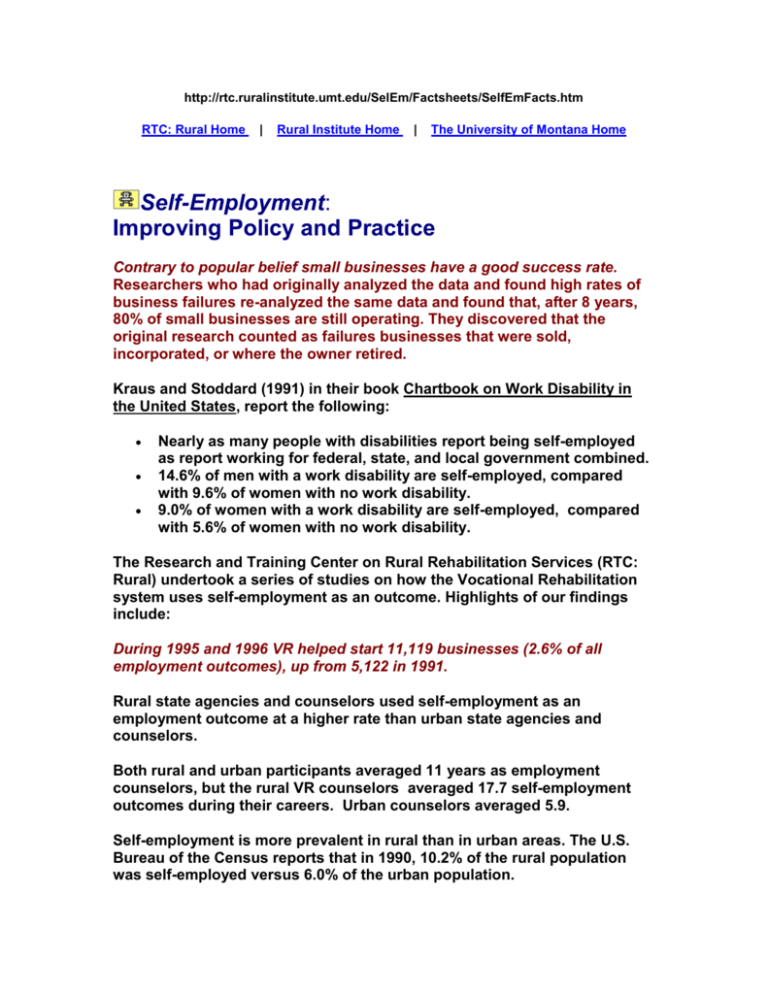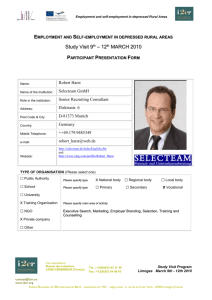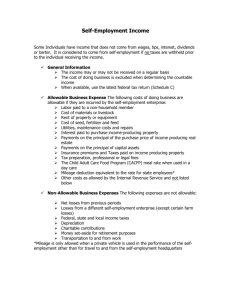DOC
advertisement

http://rtc.ruralinstitute.umt.edu/SelEm/Factsheets/SelfEmFacts.htm RTC: Rural Home | Rural Institute Home | The University of Montana Home Self-Employment: Improving Policy and Practice Contrary to popular belief small businesses have a good success rate. Researchers who had originally analyzed the data and found high rates of business failures re-analyzed the same data and found that, after 8 years, 80% of small businesses are still operating. They discovered that the original research counted as failures businesses that were sold, incorporated, or where the owner retired. Kraus and Stoddard (1991) in their book Chartbook on Work Disability in the United States, report the following: Nearly as many people with disabilities report being self-employed as report working for federal, state, and local government combined. 14.6% of men with a work disability are self-employed, compared with 9.6% of women with no work disability. 9.0% of women with a work disability are self-employed, compared with 5.6% of women with no work disability. The Research and Training Center on Rural Rehabilitation Services (RTC: Rural) undertook a series of studies on how the Vocational Rehabilitation system uses self-employment as an outcome. Highlights of our findings include: During 1995 and 1996 VR helped start 11,119 businesses (2.6% of all employment outcomes), up from 5,122 in 1991. Rural state agencies and counselors used self-employment as an employment outcome at a higher rate than urban state agencies and counselors. Both rural and urban participants averaged 11 years as employment counselors, but the rural VR counselors averaged 17.7 self-employment outcomes during their careers. Urban counselors averaged 5.9. Self-employment is more prevalent in rural than in urban areas. The U.S. Bureau of the Census reports that in 1990, 10.2% of the rural population was self-employed versus 6.0% of the urban population. People with a work disability are self-employed at a higher rate (12.2%) than people without disabilities (7.8%). Nonmetropolitan people with disabilities are self-employed at a higher rate (9.09%) than metropolitan people with disabilities (7.52%). (U.S. Bureau of the Census) Office atmosphere towards self-employment influenced a counselor's use of self-employment. The VR agency's self-employment policy and procedures influenced the atmosphere in individual offices. As part of the research, we analyzed 34 state VR self-employment policies/procedures: Almost one-third of the policies contained statements that discouraged the use of self-employment as an employment outcome. Eleven states had no written guidelines or procedures for selfemployment. Ten states required that a counselor eliminate all other viable rehabilitation options or salaried employment before considering self-employment. 35% of policies did not require a business plan. 32% of policies did not have the consumer seek outside technical assistance with developing the business. We also collected information on the types of businesses VR helped establish. One common criticism of self-employment is that the businesses consumers want to start aren't practical and are hobby-oriented, such as leather working, taxidermy, pottery. Yet, our analysis showed the businesses people start represent a wide range of mainstream businesses. Businesses VR Helped Establish: Farm, Autobody Repair Shop, Contractor, Bicycle Shop, Chiropractic Practice, Piano Refinishing Service, Auction Service, Janitorial/Maintenance Service , Weed Abatement Service, Restaurant; Free-lance Writing, Child Care Service, Welding Shop, Real Estate Office, Boat Making Shop, Air Conditioner Repair Service, Accounting Service, Bakery, Counseling Service, Used Clothing Store. Recommendations Based on our policy analysis and in response to counselor and consumer requests, the RTC:Rural developed a Model Self-Employment Vocational Rehabilitation policy, procedures for implementing the policy, and a selfemployment curriculum for VR counselors. The policy and implementation procedures combing VR practice with current best-practices for small business development. The policy has 8 components: 1. VR assesses a consumer's business potential. 2. The consumer develops a business idea, explores its feasibility, and conduct a market analysis. 3. The consumer gets any necessary education or training. 4. The consumer obtains technical assistance to develop a business plan. 5. The consumer writes a business plan. 6. The consumer determines the availability of, and applies for, funding from other sources. 7. VR reviews the self-employment plan. 8. VR monitors the business' s progress. Our analysis of 34 state VR policies/ procedures on self-employment revealed that only one state included all eight components. These components may be implemented by using a process developed by RTC:Rural in conjunction with people with disabilities, Client Assistance Programs, VR counselors and administrators, and business development consultants. RTC: Rural researchers next developed the Self-Employment Steps for Vocational Rehabilitation Counselors: Helping a Consumer Start a Business curriculum, which helps VR counselors understand the process and steps for helping a consumer start a business. Topics covered in the curriculum include: Chapter 1 Chapter 2 Chapter 3 Chapter 4 Chapter 5 Chapter 6 Chapter 7 Chapter 8 Chapter 9 Chapter 10 Why Self-Employment? Terms The Process The Feasibility Study Assessment Who Does What in the Process? The Business Plan Resources and Resource Partners Social Security Work Incentives Supported Self-Employment For people with disabilities who live in rural areas, self-employment is an option when employers and jobs are scarce, wages are low, and the jobs that are available often require physical effort. If you want to work, you may have to create a job for yourself. For more information contact Tom Seekins or Nancy Arnold RTC: Rural The University of Montana Rural Institute: A Center for Excellence in Disability Education, Research and Services, 52 Corbin Hall Missoula, MT 59812-7056; (406)243-5467(v/tt) or (888) 268-2743 rural@ruralinstitute.umt.edu References Arnold, N.L., & Seekins, T. (1994). Self-employment as a vocational rehabilitation closure, Journal of Disability Policy Studies, 5(2), 65-80. Arnold, N.L., Seekins, T., & Ravesloot, C. (1995). Self-employment as a vocational rehabilitation employment outcome in rural and urban areas, Rehabilitation Counseling Bulletin, 39(2), 94-106. Kraus, L.E., Stoddard, S. (1991). Chartbook on work disability in the United States. Washington, DC: U.S. Department of Education, National Institute on Disability and Rehabilitation Research (NIDRR). U.S. Bureau of the Census (1992). Table 22: Class of worker, work status in 1989, and last occupation of experienced unemployed: 1990. Statistical abstract of the United States: 1992 (112th ed.). Washington, DC: U.S. Government Printing Office. Produced by the Research and Training Center on Rural Rehabilitation with the US Department of Education's Research Grant #H133B70017-98. The opinions expressed in this document are those of the authors and do not necessarily represent the policy of the Department of Education, and you should not assume endorsement by the Federal government. Nancy Arnold, Ph.D. rural@ruralinstitute.umt.edu The University of Montana Rural Institute, 52 Corbin Hall, Missoula, MT 59812-7056; Toll-free: 888-268-2743; Fax: (406) 243-2349 (406) 243-5467 voice/TT Written in 1994 by Nancy Arnold, and updated July 1998. Back to Self-Employment Page | Return to Rural Employment & Economic Development Page RTC: Rural Home | Rural Institute Home | The University of Montana Home





